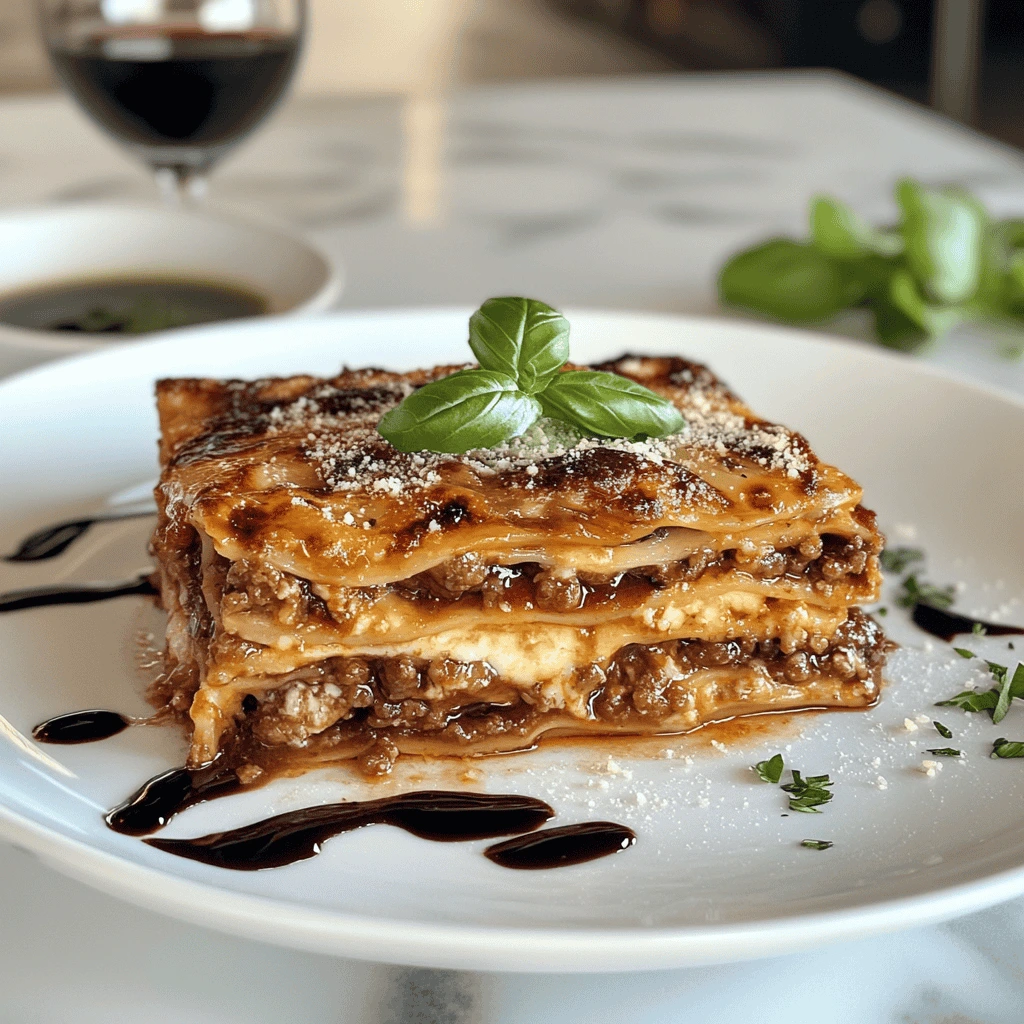👵 Part 1: Introduction & Lasagna Legacy
🏠 Welcome to Nonna’s Kitchen
There’s something sacred about lasagna in an Italian home — it’s not just a dish, it’s a ceremony. Rooted in generations of family tradition, an authentic Italian lasagna recipe is far more than pasta and sauce. It’s a warm, layered tribute to love, heritage, and Sunday gatherings.
This isn’t your American-style lasagna with heaps of ricotta and mozzarella. We’re taking you to Nonna’s kitchen, where the slow-cooked ragù, delicate béchamel, and hand-rolled pasta sheets tell a story. A story that’s been simmering for decades.
To truly understand this culinary treasure, we turn to the step-by-step guide to traditional lasagna from Eataly, which captures the heart of Italian lasagna techniques. And if you’re curious about how this dish evolved regionally, La Cucina Italiana shares the authentic lasagna culture from Italy.
🇮🇹 What Makes a Lasagna Truly Italian?
Authentic lasagna isn’t just about ingredients — it’s about balance, restraint, and honoring tradition. Here’s what sets it apart:
- Ragù alla Bolognese: Not just meat sauce, but a slow-simmered symphony of beef, pork, soffritto, tomato, wine, and milk.
- Béchamel (Besciamella): A velvety white sauce — not ricotta — made with butter, flour, milk, and a pinch of nutmeg.
- Fresh pasta sheets: Ideally made with eggs and “00” flour, hand-rolled or machine-pressed.
- Parmigiano Reggiano: Grated generously for a salty, nutty finish.
👨👩👧👦 The Role of Family & Tradition
Lasagna is more than food — it’s a Sunday ritual in Italy. Nonna’s recipe isn’t something you find on a notecard. It’s memorized, adapted, and passed down at the dinner table. The joy of sharing a bubbling tray of lasagna with family is the heart of this dish. The slow pace of layering, baking, and savoring is what makes it truly special.
If you want to dive into other traditional pasta experiences, don’t miss this classic Italian spaghetti carbonara recipe that follows the same principles of simplicity and heritage.
📋 Key Elements of an Authentic Lasagna
Let’s summarize what makes a real Italian lasagna:
- Layers of love: Alternating ragù, pasta, béchamel, and Parmigiano — no shortcuts.
- Homemade sauces: Ragù and béchamel made from scratch.
- No ricotta or cottage cheese: These are American adaptations.
- Let it rest: Flavors deepen and settle once it cools.
In the next section, we’ll break down every ingredient and technique so you can bring this cherished recipe to life.
🧄 Part 2: Ingredients & Preparations
🍅 Ingredients Breakdown: From Sauce to Pasta
Creating authentic Italian lasagna starts with getting the ingredients just right. It’s not about shortcuts — it’s about time-tested flavor. Here’s what you need for a classic lasagna from Nonna’s cucina:
- Fresh pasta sheets: Made with “00” flour and eggs, or high-quality store-bought egg pasta sheets
- Ragù alla Bolognese: Ground beef and pork, soffritto (onion, carrot, celery), tomato puree, red wine, milk
- Besciamella (Béchamel Sauce): Butter, flour, whole milk, freshly grated nutmeg
- Parmigiano Reggiano: Grated aged cheese — sharp and nutty, not to be confused with generic parmesan
- Olive oil, salt, pepper: Essentials for sautéing and seasoning
This is not a “cheat” version of lasagna. You won’t find shredded mozzarella or pre-made sauces here. If you’re looking to pair this dish with another traditional Italian favorite, try our creamy Italian pasta recipe for a full-course Italian experience.
🥩 Making the Ragù Like Nonna
In Emilia-Romagna, ragù is a sacred tradition. Here’s how to create that deep, rich flavor:
- Start with a base of onion, carrot, and celery (soffritto) finely chopped and sautéed in olive oil.
- Add a mix of ground beef and pork. Brown thoroughly to build flavor.
- Deglaze with dry red wine. Let the alcohol evaporate before adding tomatoes.
- Use passata or crushed tomatoes, and simmer on low for at least 2.5 to 3 hours.
- Finish with milk — this is the traditional Bolognese touch. It softens the acidity and adds a silky richness.
The ragù should be thick, hearty, and concentrated. It’s not soup — it’s the soul of your lasagna.
🧈 Bechamel Sauce Perfection
Many people make béchamel too thick or too bland. Here’s Nonna’s advice for getting it just right:
- Start with a roux: Melt butter, then whisk in flour. Cook for 1-2 minutes to remove raw flavor.
- Gradually add milk while whisking constantly until smooth.
- Simmer gently until it thickens to a creamy sauce — not too runny, not a paste.
- Season with salt, white pepper, and freshly grated nutmeg.
Béchamel is the creamy balance to the ragù’s richness. Skip this step, and it’s not truly Italian lasagna.
🥚 Fresh Pasta vs Store-Bought Sheets
Nonna would always make her pasta from scratch, but let’s be honest — not everyone has time. Here’s how they compare:
- Fresh pasta: Requires prep but absorbs flavors better and creates a silky texture. No pre-boiling needed.
- Store-bought dry sheets: More accessible. Choose egg-based brands for better results. Boil slightly before layering if not oven-ready.
Want to explore more Italian recipes that use fresh pasta techniques? Check out our classic spaghetti carbonara guide.
🍽️ Part 3: Assembly, Baking, and Serving
📚 Assembling the Layers
Now that you’ve prepared your ragù, béchamel, and pasta, it’s time to assemble the lasagna. This part is almost therapeutic — and crucial to the final outcome. Authentic Italian lasagna is all about even layers, patience, and precision.
Here’s the traditional layering sequence:
- Step 1: Light coating of béchamel on the base of the baking dish (prevents sticking).
- Step 2: Add a layer of pasta sheets — slightly overlapping but not piled thick.
- Step 3: Spoon over a thin, even layer of ragù.
- Step 4: Spoon over béchamel (not too much — it should complement, not drown).
- Step 5: Sprinkle with grated Parmigiano Reggiano.
- Step 6: Repeat until your dish is filled — typically 4 to 6 layers.
- Final layer: Pasta + béchamel + extra Parmigiano on top for golden browning.
For a visual and recipe-tested guide, revisit our authentic layering tips with step-by-step photos.
🔥 Baking to Perfection
Even the best layering job can be ruined by incorrect baking. Here’s how to do it right:
- Oven temp: Preheat to 375°F (190°C).
- Bake time: 30–40 minutes covered with foil, then 10–15 minutes uncovered for browning.
- Watch for bubbling edges and a golden crust on top.
- Let it rest! 20–30 minutes before serving — this helps the layers firm up for clean slicing.
Covered baking allows the flavors to infuse without drying out. Uncovering at the end ensures that golden-baked finish.
⏲️ Let It Rest: The Crucial Step
This is the step most home cooks skip — but in Nonna’s kitchen, resting is sacred. Lasagna continues cooking and setting after it’s removed from the oven. If you cut into it too early, the layers collapse and the flavor hasn’t had time to settle.
For best results:
- Cool for at least 30 minutes before cutting.
- Refrigerate overnight and reheat if you want the flavors to fully marry.
Many Italians will tell you: lasagna is even better the next day. The sauce soaks into the pasta and becomes richer overnight.
🍷 Plating and Presentation Like an Italian
Serving lasagna is more than just placing it on a plate. Italians take pride in presenting food beautifully. Here are some plating tips:
- Use a sharp knife and spatula to remove squares cleanly.
- Serve on white or ceramic plates for a rustic look.
- Add a light drizzle of extra virgin olive oil for a finishing touch.
- Garnish with fresh basil or parsley if desired — but don’t overdo it.
Pair with a glass of Chianti or Barbera, and you’ve got a meal worthy of any Sunday Italian family lunch.
🧠 Part 4: Tips, Variations, and Mistakes to Avoid
⚠️ Common Lasagna Mistakes
Even the most well-intentioned cooks can trip up when making lasagna. Here are some of the most frequent mistakes Nonna would urge you to avoid:
- Over-saucing: Too much ragù or béchamel will create a soggy, unstable lasagna.
- Uncooked or overcooked pasta: Always pre-boil dry pasta sheets if they aren’t labeled oven-ready. Overcooked pasta will become mushy.
- Skipping the rest period: Cutting too early means messy layers and lost flavor depth.
- Using the wrong cheese: Avoid mozzarella or cheddar blends — they overpower and alter the flavor.
For more insights into what not to do, check out our guide on common culinary mistakes — because precision applies to more than just poultry!
🌍 Regional Variations Worth Exploring
While lasagna Bolognese is the most internationally recognized, Italy offers numerous regional lasagna traditions. Here are a few to experiment with:
- Neapolitan Lasagna: Includes hard-boiled eggs, ricotta, small meatballs, and sausage. Often richer and denser.
- Ligurian Lasagna: Uses green pasta sheets with pesto, béchamel, and green beans or potatoes.
- Sicilian Lasagna: Layered with eggplant slices and sometimes ricotta salata.
For more Italian regional authenticity, explore the regional variations of Italian lasagna curated by the Slow Food Foundation.
🌿 Vegetarian & Modern Twists
Want to make lasagna without meat or cater to dietary preferences? Nonna would say, “Just don’t call it classic!” — but there’s still room for innovation:
- Spinach Béchamel Lasagna: Add chopped spinach to the béchamel for extra nutrition and color.
- Lentil Ragù: A hearty plant-based alternative to ground meat.
- Roasted Veggie Lasagna: Use layers of zucchini, mushrooms, and bell peppers with tomato sauce and béchamel.
Keep the layering and sauce structure the same — just swap the fillings with care to preserve texture and flavor.
📦 Meal Prep & Storage Tips
Lasagna is a make-ahead dream. Here’s how to plan for leftovers, meal prep, or batch cooking:
- Make-Ahead: Assemble the lasagna, cover with foil, and refrigerate up to 24 hours before baking.
- Freezing: Freeze fully assembled but unbaked lasagna. Wrap tightly in plastic wrap and foil. Keeps up to 3 months.
- Reheating: Bake frozen lasagna covered at 375°F for 60–75 minutes or thaw overnight and bake as normal.
- Storage: Store leftovers in an airtight container in the fridge for up to 5 days.
For freezer-friendly ideas beyond lasagna, check out our comforting turkey soup recipe for cozy days.
❓ Part 5: FAQs, Summary & Internal/External Linking
🙋 Frequently Asked Questions (FAQs)
1. What is the difference between Italian and American lasagna?
Italian lasagna features ragù alla Bolognese and béchamel sauce, layered between thin pasta sheets with Parmigiano Reggiano. American lasagna often uses ricotta, mozzarella, and marinara sauce, resulting in a richer, denser dish.
2. Can I use ricotta in authentic lasagna?
Traditionally, no. Authentic lasagna from Emilia-Romagna uses béchamel sauce. However, in Southern Italy and in regional versions, ricotta may appear — especially in Neapolitan styles.
3. How do Italians layer their lasagna?
They follow a strict order: béchamel → pasta → ragù → Parmigiano. This process is repeated for 4–6 layers, always ending with béchamel and cheese on top.
4. What meat is best for traditional lasagna?
A mix of ground beef and pork is ideal. Some families also include pancetta for added richness.
5. Why do Italians use béchamel instead of ricotta?
Béchamel offers a smoother texture and subtle richness. It balances the bold ragù without overpowering it. Learn more about authentic layering in our Italian pasta layering guide.
6. Is lasagna better the next day?
Yes! Like many Italian dishes, lasagna improves as the flavors meld. Letting it rest or storing it overnight enhances its depth and texture.
✅ Summary: From Nonna’s Heart to Your Oven
This isn’t just a recipe. It’s a tribute to generations of Italian grandmothers who’ve passed


7 thoughts on “Authentic Italian Lasagna Recipe: Straight from Nonna’s Kitchen”
Comments are closed.